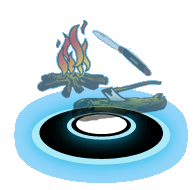Fire can be very dangerous to work with, especially if safety cautions are not being put into place.
One wrong move and a house or forest could be burnt to a crisp.
A smart and responsible scout would know when it is appropriate to build a fire and when they shouldn't.
There are approaches and techniques involved in order to successfully build a fire safely.
When conditions are not ideal, like it's during rainy season, different approaches are needed if you really want to get a fire going.
Despite the dangers of fire, people can't live without it.
We use it to cook food, as well as provide lighting and warmth on those dark, cold days; in other words, there are many uses for fire.
No matter what happens, safety is always number one.
Never leave a fire unattended, even if it's for a short time.
That's how fires can get out of control and run wild.
|
What Makes Fire, Fire?
As many may know, building fire is a science.
In order to create fire, there are three key elements that must be present at all times: Fuel, Oxygen, and Heat.
Fire must have something to burn and fuel fulfills that requirement.
When combined with the oxygen in the air and the heat from an energy source, the result is a chain reaction that creates what we know as fire.
In order for fire to stay alive, it needs the three elements named, as well as its ability to undergo the chain reaction.
When any of these elements are removed, the fire can be extinguished.
|
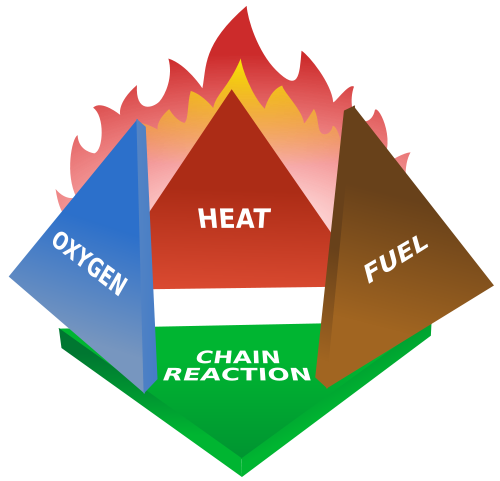
|
Preparation
Preparation is the key to everything.
Before you even think about building a fire, the first thing you have to do, prior to your trip, is find out whether or not you need a permit.
Places such as national parks, and state or federal forests will most likely require fire permits; some places might need additional permits, so be sure to check with the ranger.
With this permit it allows the individual and their group to use fire related items such as building a campfire or using stoves.
Remember, the permit and the person who signed it, must be going on the trip!
Depending of the fire danger levels and the condition of the environment, you may not be allowed to have fire at all.
It is the responsibility of the event or trip planner to contact the park or forest ranger to find out more information about the fire danger.
When you do have a fire, you should always take safety precautions because you'll never know if the weather can turn on you.
Be aware of the wind, heat, and humidity levels.
A dry, hot wind is a condition you would want to avoid making a fire in because it can turn a small fire into a wildfire.
Start a fire only when the conditions are good.
|
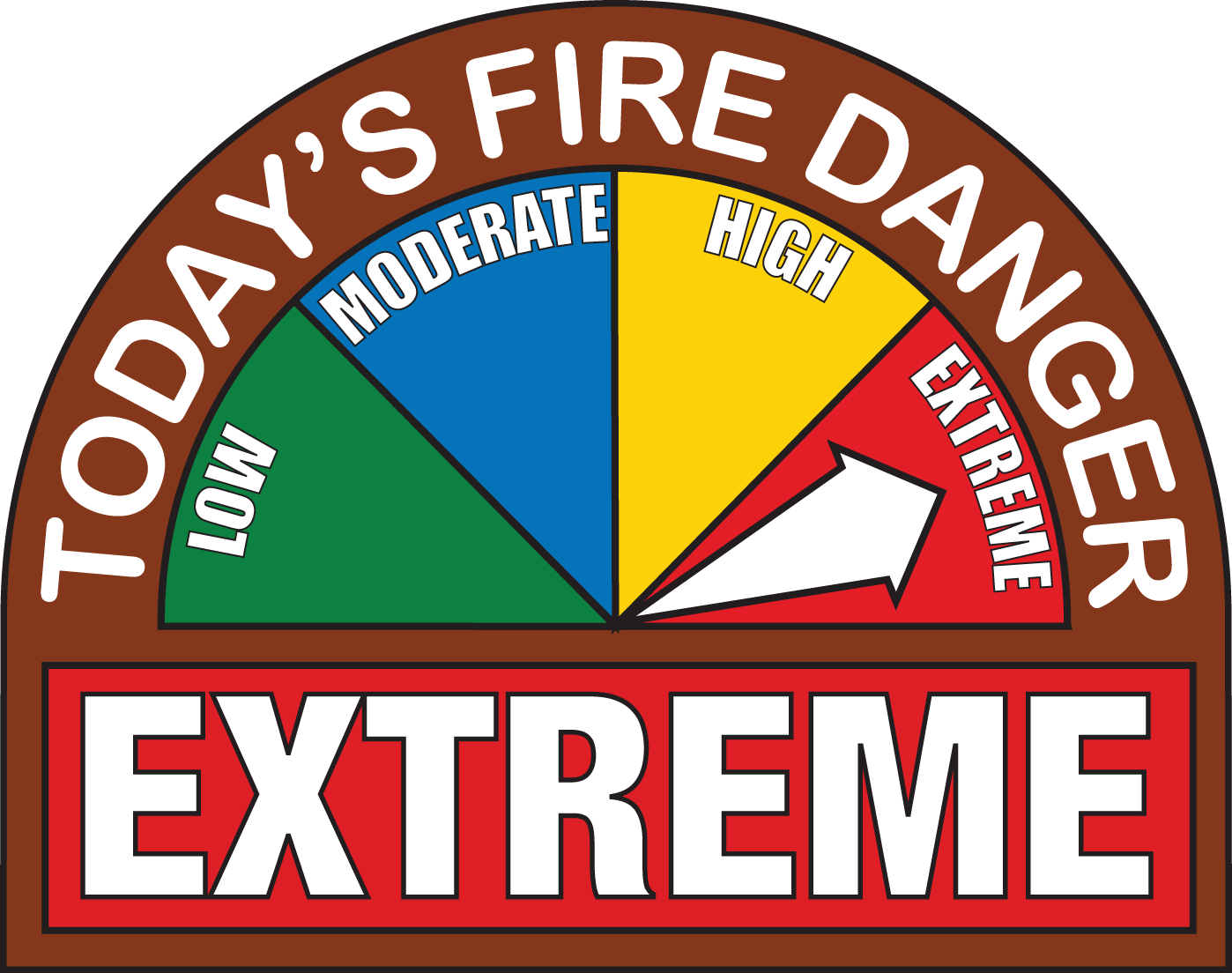
|
Building a Fire
Now that you have the required permit(s), you're ready to build a fire.
But just because the permit allows you to build a fire, that doesn't mean you could drop your gear at a random spot and start lighting things on fire.
Instead, you need to find an area that allows you to build a fire safely.
You wouldn't want to pick a spot covered with dry or dead vegetation right?
Because if that's the case your fire could make that whole area light up.
Ideally you would want to pick a spot that has already been designated to be a safe fire fires, such as fire rings or wood stoves.
If there aren't any available to you, then the next best thing is to choose an area that would do the least damage to the environment; don't forget the Leave No Trace principles!
You should consider building your fire on sand, a flat rock, or even dirt.
That way, you'll be minimizing the impact on the wilderness.
Don't forget to have water and dirt/sand nearby in case you need to put the fire out in a hurry.
|

|
Fuel Types
As noted above, preparation is key.
When building a fire, it's a good idea to gather as much fuel as needed.
However, you're going to need the right kind of fuel to even get the fire started.
Fuel is split up into three types: tinder, kindling, and fuelwood.
All three types of wood are needed when you build your fire so be prepared to go foraging in the woods.
|
Tinder
The first type of fuel is the thing that will help get your fire started: tinder.
Just remember that tinder is the type of wood that would be easy to burn; something flammable or easily combustible so the fire would catch.
Some examples of tinder would by dried pine needles, wood shavings, and clothes lint.
|
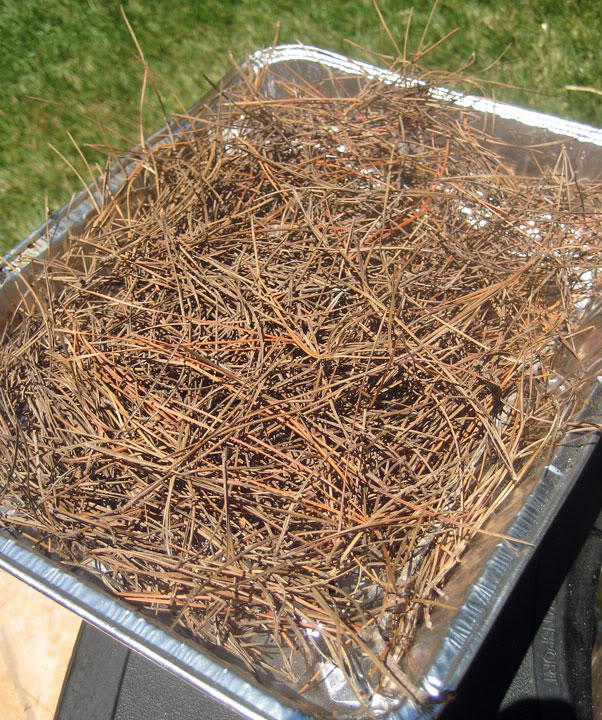
|
Kindling
After you get you're fire started with the tinder, it's time to add larger pieces of wood.
Keep in mind that the kindling aren't log sized wood, instead, they're more like branches.
You want to slowly build up the size of the fuel that you're putting on the fire.
Wood that are too big may snuff out the fire and make you start all over again. Be sure to give the fire plenty of oxygen to breathe.
A great way to identify kindling is to look for branches that are the size of large pencils or branches that have the same thickness as your fingers.
|
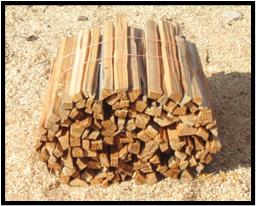
|
Fuelwood
Now that you're fire is burning on kindling, it's time to step up to the bigger sized wood: fuelwood.
This type of wood is the kind that are larger than you're forearm; maybe like a small log.
With fuelwood, it will burn down and leave behind hot coals; perfect for roasting those yummy s'mores!
|
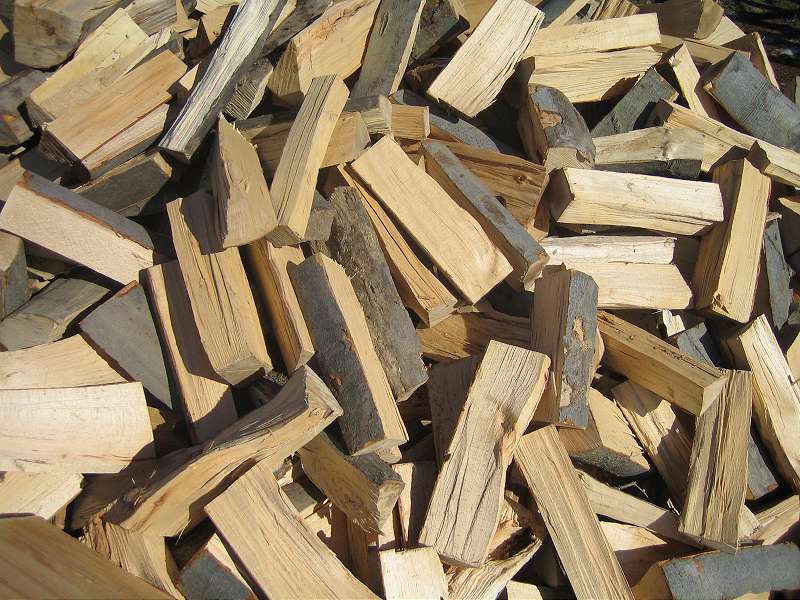
|
Fire Building Tips
Keep these handy tips in mind when you're building a fire!
- Preparation! Try to collect wood as much wood as possible. Having extra is way better than you running out of fuel halfway through the night!
- The best type of fuel is dry wood. If the wood bends, then that means it is too moist to burn. Avoid green unless you're looking to make smoke.
- Pine needles and pine cones make excellent tinder because they catch fire easily, but they burn much faster than kindling and fuel so it should only be used as a firestarter.
- If the wood is damp, split the wood. The inside may be dry and be able to burn.
|
Fire Lays
You got your spot and you gathered all the tinder, kindling, and fuelwood needed to build your fire.
So how do you start?
|
Teepee Fire
A teepee fire will, as it's name suggests, look like a teepee.
It's also the easiest to light.
This type of fire lay produces a fast flame with the heat directed up to a single point; useful for boiling water if you hang a pot above the fire.
This fire is also excellent as a signal fire since the design allows the fire to burn extremely bright.
|
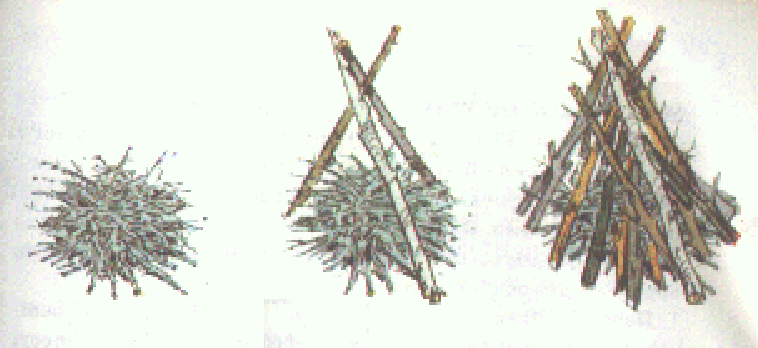
|
How To Build a Teepee Lay
- Place the tinder bundle on the ground, at the center of the fire lay.
- Form a teepee above the tinder by sticking kindling twigs in the ground.
- Lean smaller kindling twigs. (Hint: be sure to leave an opening where you could light the fire)
- Continue leaning twigs around the teepee while leaving plenty of space for air between sticks.
|
Log Cabin Fire
This type of fire lay is one of the most popular to build because it's fairly easy to make.
Although it consists of stacking wood on top of one another in a square shaped pattern, it makes it more difficult to access the inside as opposed to the teepee lay.
This type of fire is good for making coals and using the coal as a cooking fire.
|
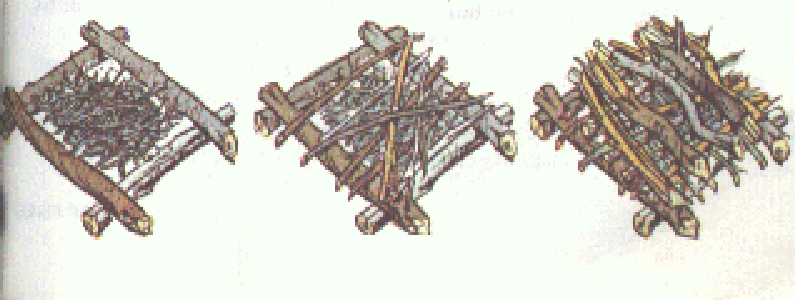
|
How To Build a Log Cabin Lay
- Set a tinder bundle on the ground
- Lay two large pieces of fuelwood parallel to each other with the tinder bundle in the middle (you'd want the sticks to be long enough to reach each other when you start stacking them).
- Lay two smaller pieces of fuelwood parallel to each other on the opposite side. Don't forget to leave a spot where you could light the tinder.
- Continue laying smaller pieces to form a cabin shape.
|
Lean-To Fire
The lean-to fire lay has a support stick that allows lots of airflow.
It's easy to light, but the drawback is that the tinder may burn up without catching the kindling on fire.
After the fire starts burning, the support stick with eventually catch fire and fall.
This fire is normally built to direct the heat of the fire in a specific direction, such as towards you.
|
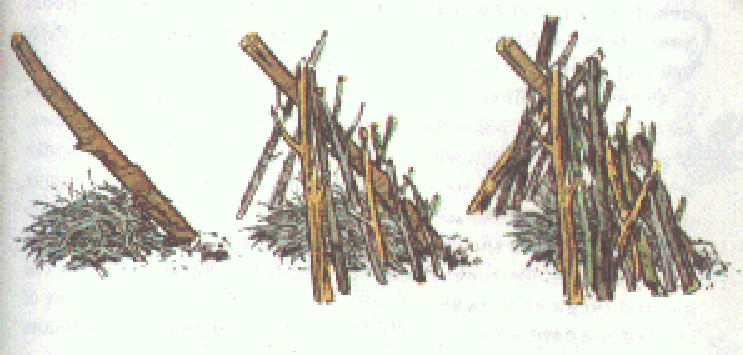
|
How To Build a Lean-To Lay
- Find a long, large piece of kindling to use as your support stick and stick it into the ground at an angle.
- Set the tinder bundle on the ground under the support stick.
- Lean small pieces of kindling on the tinder bundle and the support stick.
- Move on to leaning larger kindling.
|
Starting Your Fire
After you built your fire lay, its time to light things up.
There are several ways to light a fire, matches are the most common way, but there are also many other techniques that can be used to light fires.
|
Matches
These are the simplest and most common way of lighting a fire.
The head of these little paper/wooden sticks are coated with a type of phosphorus that ignites from the heat of friction when struck.
They come in regular, waterproof, and windproof matches (dangerous and very flammable).
Also keep in mind that not all matches are “Strike Anywhere” matches where the matches can be lit by striking a rough object.
If you don’t have Strike Anywhere matches, make sure you bring the striker.
|
Lighters
Lighters come in a small device filled with a flammable fluid or pressurized liquid gas.
With the flick of your thumb a spark is created to make fire.
It's a good tool to use, but be wary of the setbacks you may encounter such as cold temperatures, fuel leaks, high altitude, and lack of fuel.
|
Flint and Steel
Flint and steel is one of the well known methods of starting fires.
This process consists of striking metal against the flint to create sparks.
Unlike matches and lighters, flint and steel will not run out of fuel or be affected by cold temperatures; however it does require patience.
|
Friction
Creating fire by friction can be quite a challenge.
This technique basically uses the heat of the friction created by the individual to create a small coal piece that could be used to light the tinder bundle.
Methods of fire by friction include the fire plow, hand drill, and the bow drill.
|
Steel Wool and Battery
With the use of steel wool (strands of fine soft steel filaments) and a battery normally a 9V battery, you can make sparks using electricity.
All you have to do is touch the steel wool to the positive and negative contacts of the battery and the steel wool will burn.
|
Sunlight
You probably heard of the kid who burned ants with a magnifying glass right?
Well, when you concentrate the sun's rays into a single point, you can generate enough heat to light tinder.
There are several objects that you can use to do the same: magnifying glass, bottom of the soda can, water in clear plastic, and even ice.
|
Fire Safety
As mentioned earlier, fire is a dangerous thing.
So it's extremely important to observe safety measures as much as possible.
Never leave the fire unattended - under no circumstances should you leave a fire to burn all by itself. If you have to leave the area with the fire still going, you must have someone watching it.
Only use fires when situations or land authority allows - be sure to have the necessary fire permits.
Always have fire fighting gear prior to building and starting a fire - have water, sand/dirt with you in case you need to put the fire.
Use the Cold-Out test - if the fire isn't cold enough for your hand to touch, then the fire is not out yet.
|
Firem'n Chit
To show that a scout is certified and has the right to carry matches and build campfires, the Boy Scouts of America created the Firem'n Chit.
Without this card on their person, a scout would not be allowed to carry or work with any fire-related items.
|
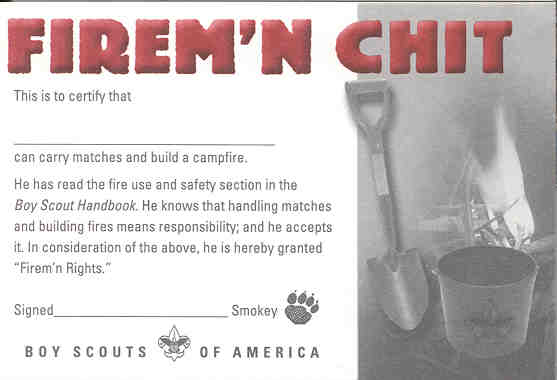
|
This card shows that the scout has read and understood the use and safety rules in the Boy Scout Handbook and follows the responsibilities that come with the card.
To earn this certification, a scout must show the Scoutmaster or any other designated individual that the following requirements have been met:
- I have read and understand use and safety rules from the Boy Scout Handbook.
- I will build a campfire only when necessary and when I have the necessary permits (regulations vary by locality).
- I will minimize campfire impacts or use existing fire lays consistent with the principles of Leave No Trace. I will check to see that all flammable material is cleared at least 5 feet in all directions from the fire (total 10 feet).
- I will safely use and store fire-starting materials.
- I will see that fire is attended to at all times.
- I will make sure that water and/or shovel is readily available. I will promptly report any wildfire to the proper authorities.
- I will use the cold-out test to make sure the fire is cold out and will make sure the fire lay is cleaned before I leave it.
- I follow the Outdoor Code and the principles of Leave No Trace.
The Firem'n Chit card has four corners and these corners represent the number of infractions that a scout may have performed.
Any violation of these rules will result in a missing corner.
When all four corners are gone, the scout has lost his/her Firem'n Chit rights.
|





